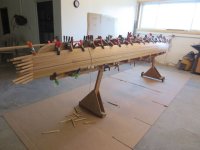Very nice, Jim. This reminds me that I need to snag a couple tubes from the garage and make up a set of 2 inchers for my spring build. Good winter project.
Easy to make !
Jim
Very nice, Jim. This reminds me that I need to snag a couple tubes from the garage and make up a set of 2 inchers for my spring build. Good winter project.

You will like them, where you use staples or not. To me ? They take the place of another set of hands, when laying up the strips !Very nice, Jim. This reminds me that I need to snag a couple tubes from the garage and make up a set of 2 inchers for my spring build. Good winter project.
No pun intended?Very nice, Jim. This reminds me that I need to snag a couple tubes from the garage and make up a set of 2 inchers for my spring build. Good winter project.
They'll work just fine without the tubing. I've been building with bead & cove and using these Jimmy clamps without any tubing to protect the coves. They work great and, honestly, I haven't seen much, if any, damage to the cove edges....although maybe just without the piece of tubing on them, and just leaning on the friction between the rubber and the strips?
Yes. I liken them to a third hand, for hold strips.I love ideas and applications like this. Thanks for sharing the diy method! These clamps look awesome and I do like the idea of building stapleless. As someone with a very limited shop space and no router table I am debating the robo-bevel from Guillemot, and doing a rolling bevel when my first build comes around. I imagine these clamps would still work well in a rolling bevel scenario, although maybe just without the piece of tubing on them, and just leaning on the friction between the rubber and the strips?
